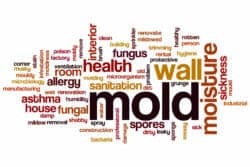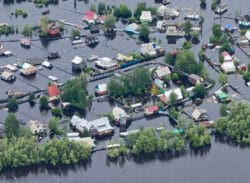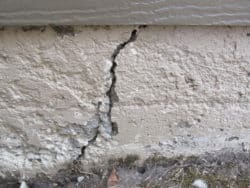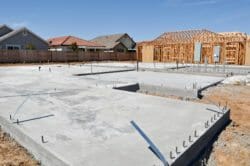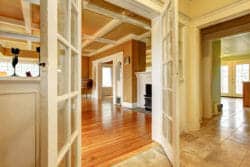Checklist For Discovering Structural Flood Damage To A Home
Home » Structural »
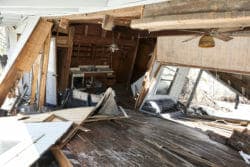
Floods cause tremendous structural damage to homes, sadly, much gets overlooked until months or years later. It’s important to check a number of things as soon as the flood is over, and few may need to be acted on promptly or more server damage will occur.
Structural damage may be categorized as damage to the foundation and damaged to the structure (house) sitting on the foundation. It is not uncommon for both to suffer damage in floods. As homeowners or buyers, we need to be aware of the basic forces or causes of the damage, so that we understand the importance of what we see and what to check.
Engineers
When describing causes of damage to homes from flood waters and flooding “Engineers” will often refer to the following:
Hydrostatic load / pressure
In a flood hydrostatic pressure is the amount of pressure exerted by still water against a homes’ wall, foundation, basement wall or slab. It will put pressure on foundations or flow through cracks, holes or even seep through solid concrete. If the water level outside of the home is the same as the inside of the home, then the pressure or force is balanced.
Hydrodynamic loads / pressure
Pressure from water flowing around a house during a flood creates hydrodynamic pressure on the house. The higher the velocity of the water, the greater the pressure on the frontal side of the flow and on the backside, there is usually a suction force.
Lateral pressure from moving water may cause walls to separate, floors to break apart, the house to collapse or even be pushed off its foundation.
Buoyancy and buoyant forces
The buoyant forces of flood water may cause a house to float or come loose from its foundation; these uplifting forces are more likely to affect homes that are on raised foundations or pier and beam foundations (sometimes called post and beam). In these types of homes, the connection points may not be insufficient to withstand the tremendous uplift forces of flood waters. Another factor is that most homes have wood framed floors, walls and roofs; and we all know that wood floats.
In only two foot of water, cars may float and the same is true with some houses.
Impact loads or forces
Engineers will often site impact loads as the cause of structural damage to a home. Impact loads include floating debris, waves, currents and turbulence. The debris may be tree limbs, automobiles, sections of other homes, propane tanks and furniture to name just a few.
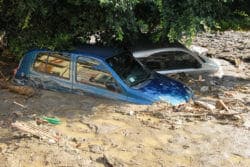
Debris in flood waters
Significant damage can occur when debris floats through flood waters. Heavy tree trunks, large limbs, automobiles and debris from other homes gets pushed about easily; when heavy objects hit or are push up against a homes’ wall, damage occurs. Walls, wood studs, floor joist as well as rafters and trusses are dislocated and damaged; floors may buckle or shift, and the roof structure may sag or collapse.
Debris hitting a home is a little like hitting it with a sledge hammer, except instead of weighing 10 or 15 pounds, a tree trunk or car may weigh several thousand pounds; a force 200 times more powerful.
For us non-engineers
We need to know that the pressure exerted on a foundation, basement or the walls of a home are really strong, that:
- If there is a three-foot differential between the water level inside the house and the outside of the house; that there will be approximately 60 to 65 pounds of pressure per square foot pushing against the house (in still water). A three-foot differential would be like 180 to 200 pounds per square foot: so just imagine the pressure against a house with walls 40 or 50 feet long and 8 or 10 feet high.
- If the flood water is moving at a speed of 10 miles per hour, it may exert the same pressure as a wind gust of 270 miles per hour.
The Bottom Line is that floods cause significant damage to homes and in some instances totally destroy them.
Structural Damage Checklist
Framing structural checklist
A framing checklist is basically dealing with wood framing issues of the home where structural damage may have occurred.
First, step back from the house and look at it from a distance, perhaps 50 to 100 feet back which will give you an overall impression of the exterior of the structure. Do this for all four sides of the home.
Big picture
- Does the house appear to lean or tilt?
- Are there sections of the house that has broken away or that’s damaged?
- Has the house shifted partially off the foundation?
Roof
- Does the roof sag or bow in places?
- Is the roof wavy?
- Are there any humps that weren’t visible before?
- Any areas where there’s a section of roof missing?
- In the attic are there any cracked, broken or damaged rafters or trusses?
- Does the roof sheeting show any evidence of moisture damage, staining or swelling? If so…
Fireplace Chimney
- Does fireplace lean or bow?
- Has the chimney separated or pulled away from the house somewhat?
- Any cracks in the brick or stones, any loose bricks or stones?
Exterior walls
- Are there any bowed, wavy or damaged walls? Stand at each corner of the house and site down the wall. Also, check that the wall is secured to the top of the foundation and hasn’t shifted: is the wall connection to the foundation damaged?
- Roof connection to the wall. Is it proper or is there gaps, damage or out of alinement?
- Was the wood framing in the walls subject to being under water for extended time periods? Wood framing should not exceed 19% moisture content or mold and mildew will develop.
Ceilings and floors
- Do the ceilings or floors sag?
- Are floors spongy when walked upon?
- Are the floors wavy or has a slope that they never had?
Doors and windows
- Are there gaps at the doors and windows?
- Do doors and windows stick or fail to open or shut?
- Any self-closing or self-opening doors?
If basement
- Are there cracks in the wall?
- Walls lean or bowed?
- Do walls appear pushed in or out?
- Beam or post supporting first floor – any cracked or damaged?
Foundation structural checklist Link
(click on this link for foundation checklist)
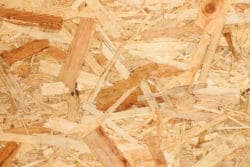
Structurally has any Plywood or OSB Board lost its strength?
A homes’ exterior wall may be sheeted with plywood or OSB board (Oriented Strand Board) to help provide shear wall (lateral) support and strength; very important in helping homes from incurring damage during earthquakes and strong winds.
Roofs usually have plywood or OSB board sheeting that supports the weight of the roofing materials on it, i.e. shingles or tiles.
Floors often have plywood or OSB board sub-floors.
Should flood waters soak or cover these two materials, especially for extended periods of time, they may lose part of their structural strength as well as having delamination problems, swelling and edge issues. This damage can affect the structural strength of a home.
If the roof is sheeted with OSB board and covered with composition shingles, there may be a “ghost line” reflected through the shingles where the edges of the OSB board have swollen from water intrusion. If not dried properly, deterioration may occur and fasteners may fail.
Checking for moisture damage, swelling, delamination and other defects is wise and although these materials can handle limited amounts of water and still retain their strength, they may fail if they have had too much water exposure. Also, fasteners such as staples or nails may rust or fail.
Connections and hardware
When accessing structural issues, be sure to examine metal connectors, metal hangers and ties. When excessive loads and pressures are present, these may come loose, bend or fail to hold various components together. Not only should the hardware be checked, but wood framing that they’re attached to may be cracked or damaged.
Examine the metal connectors and hardware for rust and corrosion. If badly rusted or corroded, then replacement is recommended.

A structural engineer review
If unclear about the seriousness of flood damage to your home, obtaining the services of a structural engineer may be wise. At first a preliminary investigation by an engineer might be sufficient to determine if there is even a need for an in-depth review.
If there is going to be an insurance appraiser reviewing the property, and you feel there is significant structural damage or you’re suspicious that there is the possibility of hidden or server damage, then having a structural engineer look at the property first would be prudent. That way certain things that might be overlooked by the appraiser can be brought to the appraisers’ attention. Also, the appraiser may be a little more attentive to discovering damage, if he knows that the home has been examined by a structural engineer.
At times a qualified general contractor may be able to examine the structure and provide meaningful information. Regardless of who you seek advice from know their qualifications and experience.
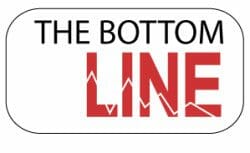
Flood damage is not just about the contents, but it’s about the structural integrity of your home
Even if water never enters your home you may have structural damage to the foundation.
After a flood, life becomes chaotic and homeowners may not realize that there is structural damage because they are dealing with a hundred other issues; insurance, clean-up, repairs, kids and school, work, etc. etc.
In order to avoid overlooking serious and costly structural issues, it is prudent to do a review of both the foundation and the structural components of the home sitting on the foundation.


